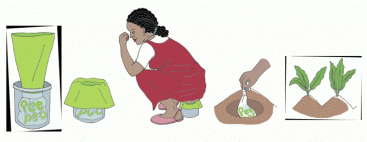Useful "Flying Toilets"? Part 2
My previous post introduced the concept of Peepoo and why it was regarded as a potentially viable and remarkable invention contributing to improving sanitation. It does not, however, come without its shortcomings.
Men are skeptical. They are reluctant to make the switch from conventional toilets to the Peepoo bags, afraid of gossip and ashamed of using this service in their own home. An interviewee stated: "At home you should not go to the bathroom", which seems like a backward but deep-rooted cultural way of thinking. There is clearly a stigma that surrounds the whole topic of human excretion, and those who are opposed to the Peepoo bags claim that it is unhygienic to use them, and that using the conventional, dirty, expensive toilets is the right way to go about doing things. This struck me as the most ironic and surprising part of the video. As someone who has had the fortune of growing up in modern, clean and developed cities, having a toilet at home is a given privilege. Yet for these men, toilets should not be in their home. These cultural differences may impact potential and maybe even past opportunities for improved standard of sanitation to not be fully realized to its potential. When going around her rounds collecting bags, shouts of "Poo women!" or similar are heard, and Miss Auma states that some also look down on her, because she stinks. For a community in dire need of better sanitation , the least they could do was not to look down on Miss Auma for improving their situation. The Peepoo website also states that someone collecting waste would stimulate local economy and be an integral part of a more sanitary way of living, and that they would be appreciated by the community (PeePoople, 2016). Unfortunately, this does not seem to be the case. Undeterred, Miss Auma states that she is happy with the job as long as it enables her to feed her children and take care of them.
Fig. 1: How Peepoo bags are used from excretion to soil fertilizer
Shifting to a more ecological aspect of the Peepoo bags, the concept of human excreta as fertilizer is a rather controversial. The farmer in the video explains that these bags must quickly be covered by soil when delivered, as people would not eat the crops if they knew that it was grown by human poop. There is cultural resistence and fears over contamination of food as its use as human fertilizer (Redfield, 2018). On the contrary, crops gown by Peepoo actually provide more nutritious meals, contributes to food security and creates a sustainable sanitation model that is easily scalable and can be duplicated in urban slums throughout the world (Peepoople, 2016).
Fig 2: Step-by-step process on how to use Peepoo bags- prep time may be a hindrance if need to be used urgently
Another problem Peepoo struggles with is its technical design. There have been complaints about the difficulty of using the Peepoo bag, including inadequate circumference to spread the bag over a container and inadequate length which inhibits proper knotting. Patel et. al (2011) argue that the prep time for Peepoo may also be a hindrance if people need to use them in a hurry, and standard bags are actually preferred with children and disabled people because of ease of use. Peepoo bags are appreciated for their ability to contain odour, though if contained and properly disposed of users are apparently likely to be comfortable with any type of bag. However, this would not be the sustainable, closed loop solution Peepoo hopes to be, and instead generate more waste. Hence, availability of Peepoo for its potential users must be achieved, or people might pick up behaviour of defecating in bags without added benefit of biodegradation or pathogen reduction (Patel et. al, 2011). This will require more robust method of distribution and monitoring, which will be labour intensive in large camps (ibid).
The size of the bag has proved to be tricky, since the goal was for the bag to be just large enough for a single use, but not too large as it this might encourage reuse and counteract its hygienic ambition (Redfield, 2018). Users felt that a larger bag might allow women to urinate and defecate simultaneously, but are worried about the temptation to use the bag repeatedly, which might upset the sanitation process to kill pathogens as the amount of urea placed in each bag is balanced to the size of the bag (von Münch et. al, 2009). Patel et. al (2011)'s study suggests that size should at least be enlarged from 52cm to 63cm, length to be increased from 38cm to at least 43cm, and to relook at the packaging because of leakage from small tears. The product should be examined from shelf-life and storage requirements, which might be very short since biodegradable material is sensitive and deteriorates by design. Hence, Peepoo bags cannot sit and bide its time, making their turnover much quicker (Redfield, 2018).
This brings me to an overarching topic that I am curious about. With a product like Peepoo with such potential, I would like to further understand how successful it can be launched under a social entrepreneurship, especially since it is a product with a short life span and something that require regular use and production if high in demand. This will be further explored in my subsequent post about social entrepreneurship and sustainable business.


Comments
Post a Comment